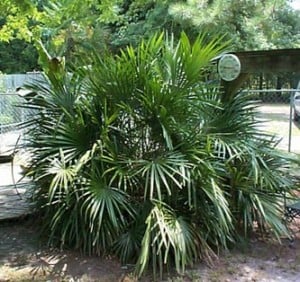 Can I plant a palm tree here? Yes, you can! There are several palms that will survive and thrive in upstate South Carolina.
Sabal palmetto is the state tree of South Carolina. It is known as a Palmetto or Cabbage palm and is one of the most common native palms in the United States. Cabbage palms transplant well but once roots are cut they do not branch and must produce new roots from the base of the trunk. Therefore, they require at least 8 feet of clear trunk to survive transplanting, preferably 10 feet.
Butia capitata is commonly referred to as a Pindo or Jelly Palm. They are called Jelly palms because their fruit makes a tasty pineapple/banana jelly. They are the only palm hardy to our area that has a feather shaped frond. Pindos have a thick, slow growing trunk and a typical height of 15 feet. The foliage is blue-green or silver-green. This palm is typically booted.
Trachycarpus fortunei is commonly referred to as the Windmill or Chinese windmill palm. They are among the hardiest of palms, able to withstand fairly severe freezes with no damage. They can reach heights of 25 feet or more. The trunk is smaller in diameter than the other palms that grow in this area and is covered in dark brown fibers that age to gray.
Chamaerops humilis is referred to as a European Fan Palm. It has a slow growth rate and a typical height of 10 feet, which makes it great for container planting. It is quite spiny, having orange teeth on the petiole (leaf blade).
Palms in this area do not typically have many pest or disease problems. They do need fertilization, recommended three times per year in April, June and August. A good fertilizer is 8-10-10, applied at a rate of 3 cups per tree. Micro-nutrients that benefit palms are manganese and magnesium. Magnesium deficiency is first noticed as yellow bands on the older fronds. Manganese deficiency affects the newer fronds. They emerge stunted, yellowed and frizzled looking. Fertilizing after August is highly discouraged due to cold damage that could occur on tender new growth. Sometimes the Palmetto palm will develop powdery mildew but it is controlled with a general fungicide.
Thank you for reviewing this information. Schneider Tree Care is committed to preserving and enhancing the quality of your property through tree care education and services. We employ professionally trained and certified arborists who are available to meet with you for a consultation at no charge.
If you have any questions or need additional information regarding the health of your trees, please contact us.
Can I plant a palm tree here? Yes, you can! There are several palms that will survive and thrive in upstate South Carolina.
Sabal palmetto is the state tree of South Carolina. It is known as a Palmetto or Cabbage palm and is one of the most common native palms in the United States. Cabbage palms transplant well but once roots are cut they do not branch and must produce new roots from the base of the trunk. Therefore, they require at least 8 feet of clear trunk to survive transplanting, preferably 10 feet.
Butia capitata is commonly referred to as a Pindo or Jelly Palm. They are called Jelly palms because their fruit makes a tasty pineapple/banana jelly. They are the only palm hardy to our area that has a feather shaped frond. Pindos have a thick, slow growing trunk and a typical height of 15 feet. The foliage is blue-green or silver-green. This palm is typically booted.
Trachycarpus fortunei is commonly referred to as the Windmill or Chinese windmill palm. They are among the hardiest of palms, able to withstand fairly severe freezes with no damage. They can reach heights of 25 feet or more. The trunk is smaller in diameter than the other palms that grow in this area and is covered in dark brown fibers that age to gray.
Chamaerops humilis is referred to as a European Fan Palm. It has a slow growth rate and a typical height of 10 feet, which makes it great for container planting. It is quite spiny, having orange teeth on the petiole (leaf blade).
Palms in this area do not typically have many pest or disease problems. They do need fertilization, recommended three times per year in April, June and August. A good fertilizer is 8-10-10, applied at a rate of 3 cups per tree. Micro-nutrients that benefit palms are manganese and magnesium. Magnesium deficiency is first noticed as yellow bands on the older fronds. Manganese deficiency affects the newer fronds. They emerge stunted, yellowed and frizzled looking. Fertilizing after August is highly discouraged due to cold damage that could occur on tender new growth. Sometimes the Palmetto palm will develop powdery mildew but it is controlled with a general fungicide.
Thank you for reviewing this information. Schneider Tree Care is committed to preserving and enhancing the quality of your property through tree care education and services. We employ professionally trained and certified arborists who are available to meet with you for a consultation at no charge.
If you have any questions or need additional information regarding the health of your trees, please contact us. 




